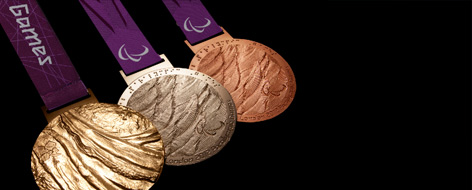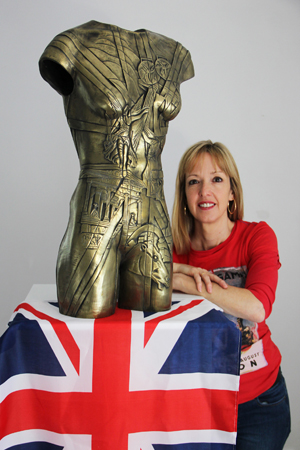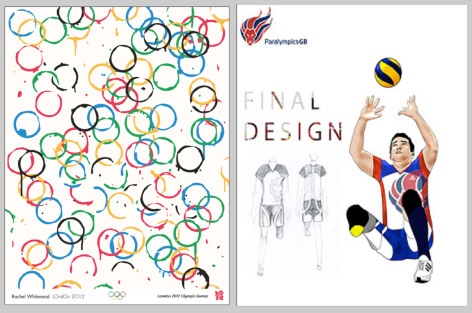The build up to the London 2012 Games allowed the Faculty of Arts to celebrate the Olympic ideal.
15 Aug 2013

The games at Olympia ran for a thousand years as a festival not only for athletes but for artists. Sculptors and poets were part of the ancient festivities, and our knowledge and appreciation of those times comes in many ways from the art and culture that has been handed down, Myron’s Discus Thrower among them.
The ancient games were a celebration of human achievement and excellence and, as the games for London 2012 begin, the country takes its chance to celebrate the Olympic ideal: not just the competitive sport, but also the cultural and artistic context in which sporting participation, excellence and enjoyment can thrive.
Our Faculty of Arts at the University of Brighton is proud to be associated with many projects that evolved in response to the build-up to the games, and proud to live up to the ideals represented by the London 2012 Games through our staff and students who have contributed in many different ways:
Alumni who have contributed to the art and design of the games include Lin Cheung, designer of the Paralympic Games medals. She graduated in design in 1994 and is now a regular visiting lecturer on the Design and Craft BA(Hons) course.

Graduate Louise Giblin created body casts of five Olympic athletes to raise money for brain injury charity, Headfirst. Louise, who was taught by sculptor Anthony Gormley graduated in Fine Art Sculpture BA(Hons) in 1985. She worked on the casts of Dame Kelly Holmes, Kriss Akabusi, Sally Gunnell, Darren Leach and gymnast Beth Tweddle over a nine month period and was invited to show her work at the British Olympic Federation charity ball held at British Olympic Chairman, Lord Colin Moynihan's estate. Lord Moynihan will also become one of the models for Louise's next project, her Living Legends exhibition taking place in 2014.
Visiting lecturer and alumnus, Pascal Anson’s design for the new livery for British Airways planes flying in teams for the Olympics was chosen by the airline as part of its Great Britons Olympic programme. Turner Prize winning artist and Brighton graduate Rachel Whiteread is one of the artists who have designed a poster for the 2012 Games posters and those images are currently on show in a free exhibition as part of a high-profile promotion of the 2012 Games.
Organised as a joint inititative by the Universities of Brighton and Sussex, the Creative Campus Initiative spent the three years leading up to the London 2012 Games fostering a consortium of thirteen higher education institutions in South East England to bring a dynamic programme of cultural events and artworks in response to the London Games 2012.
Projects responding to sporting themes included creative writing, digital medical scanning, sound art and music, film and moving image, dance, fashion, graphic and product design and public art. ‘Almost Steven Gerrard’ won the The Creative Writing Olympics Anthology gold medal, part of an anthology that explored new and existing connections between art and sport through the medium of creative writing and which evoked the many emotions that evolve through sport.
Our designers ran Bodies Beautiful: Paralympic sportswear and equipment design, a cross-disciplinary and community partner project led by Malcolm Mcinnes, Dr Jyri Kermik, and Tom Ainsworth, while our diploma Architecture student project Unlocking Space was based on the work of mapping and visualising open urban space in the Ditchling Rise area of Brighton and Hove, investigating land that has scope to be more intensively used for both sporting and cultivating activities.
 Images: (above left) former student Rachel Whiteread's poster design: (above right) paralympic design project work 'Bodies Beautiful': (top) Paralympic medals designed by former student Lin Cheung.
Images: (above left) former student Rachel Whiteread's poster design: (above right) paralympic design project work 'Bodies Beautiful': (top) Paralympic medals designed by former student Lin Cheung.From our graphic design and illustration subject area, Professor George Hardie’s Metaphorical Measurements brought graphic design eyes to a the measurements involved in some 30 of the Olympic and Paralympic sports, producing a pulp book and posters.
Innovative performance arts in Creative Campus included Endeavour, where dance and music brought new understanding to physical education teaching; Informathlon, which used interactive media to allow for the exploration and visualisation of stories and data emerging from the Olympics; the Faculty’s Voice Lab-created sound performance The Musical 100m; and Subtle Objects: Pick up, in which, working with sports kit and equipment, researcher Mike Blow captures sounds relating to when the object was made as well as the particular noises at a game or match, producing evocative soundscapes of laughter and ominous sounds.
Auditoryum: is a site-specific three-dimensional interactive sonic artwork using ambient sounds of the sporting arena. Created by Dr Sarah Atkinson and Marley Cole for the Creative Campus first stage, the two researchers were then developers of the 1908: Body and Soul project, which recalled the first London Games of 1908 and, drawing on the sports history expertise of Professor Alan Tomlinson, fused performance, sport, circus and immersive sound in an experimental media production event.
As part of the legacy of the Games, Andre Viljoen, researcher in urban architecture, is briefing the Olympic Park Legacy Company's real estate team on how to boost the Olympic Games' green legacy and integrate urban agriculture into the post-Games development of the Olympic Park in Stratford. Then, in a follow up to the games in September, the faculty will be hosting The Design History Society’s international conference: The Material Culture of Sport is convened by design theorist Paul Jobling. This embraces research in the material culture of professional and amateur sport in all its manifestations, from and across different historical periods, and from various theoretical and methodological perspectives.
The Faculty of Arts has embraced the spirit of Olympic competition and, as an institution, the University of Brighton has proved that culture, arts and design join sport in celebration of our twenty-first century perspective on what is best about human beings, bringing the Olympic ideal to the new generations who join the university each year.
If you're interested in following the connections the University of Brighton has developed with the London 2012 Games, there is a special Olympic and Paralympic webpage: http://www.brighton.ac.uk/london2012
